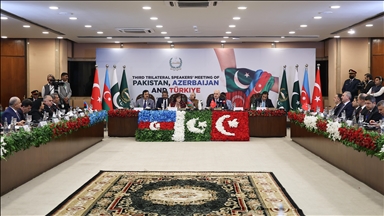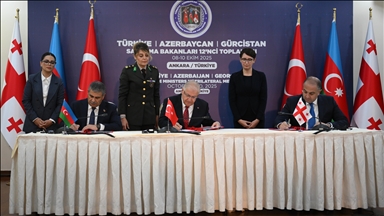Why is Lachin corridor crucial in context of Karabakh region?
After start of protests by Azerbaijani environmentalists on Lachin road last month, tensions between Baku and Yerevan on corridor reignited

ISTANBUL
Thirty days have passed since Azerbaijani environmentalists, representing various non-governmental organizations, began protesting on the Lachin road over the illegal exploitation of natural resources by Armenia in the Karabakh region, a region internationally recognized as a part of Azerbaijan.
Armenia claimed that the ongoing protests resulted in the road’s closure on Dec. 21, while Armenian Prime Minister Nikol Pashinyan called the situation at the Lachin corridor a "crisis" demanding immediate attention, during a Dec. 27 meeting with Russian President Vladimir Putin in Saint Petersburg.
Azerbaijan has repeatedly denied these claims, citing the unhindered traffic of vehicles belonging to the Red Cross and the Russian peacekeeping contingent in the region, which was stationed in the aftermath of the Second Karabakh War in the fall of 2020 and a January 2021 pact that followed.
The protests reignited political tensions between the two countries, which have been working towards the signing of a peace agreement, and resulted in the breaking of diplomatic dialogue, even with efforts towards international mediation.
But what makes this corridor so crucial that tensions between Baku and Yerevan have intensified with a focus exclusively on this matter?
Natural resources
The Karabakh region is home to various natural resources, among which minerals such as nonferrous metal ores and gold are the most important.
According to Musa Mammadov, head of the Department of the Institute of Geology and Geophysics at Azerbaijan’s National Academy of Sciences (ANAS), more than 160 deposits of various precious metals in the occupied territories of Azerbaijan were exploited by Armenia, the Trend news agency reported on Nov. 13, 2020.
The Karabakh region, and seven adjacent regions – including the Lachin region – were liberated from nearly 30 years of Armenian occupation in the fall of 2020 after 44 days of fighting that ended after a Moscow-brokered cease-fire.
Last May, under a presidential order, three mines – Kashkachay, Elbeydash, and Agduzdag – were transferred to two Turkish companies for the purpose of study, research, exploration, development, and exploitation based on a 30-year contract.
Protests by Azerbaijani environmentalists in the region began on Dec. 12, a day after Azerbaijan sent a diplomatic note to Russia concerning the "illegal exploitation" of natural resources in the area, as its officials were prevented from entering the area a day earlier.
An Azerbaijani Foreign Ministry statement said that illegal exploitation and looting of natural resources had been seen, especially in the Kyzylbulag gold and Demirli copper-molybdenum mines, which are accessible only through the Lachin corridor.
The communique said that negotiations were held between the two sides and an agreement was reached on Dec. 10, but Azerbaijani officials were still blocked from visiting the area.
Only corridor between Armenia, Karabakh
The Lachin corridor is the only land route between Armenia and the mountainous region, which is home to a significant ethnic Armenian population.
Since the end of the 2020 conflict, Baku has said it is ready to meet the humanitarian needs of the Armenian residents living in the territories of Azerbaijan, adding that Armenians with Azerbaijani citizenship living in the city of Khankendi will be able to travel to and from Armenia through a new planned corridor in the region.
However, Azerbaijan also noted that Armenia has been preventing the implementation of such projects which were envisioned under the Trilateral Agreement of Jan. 11, 2021 between Baku, Moscow, and Yerevan.
According to a statement by Azerbaijan’s Mission to NATO, Armenia has been misusing the Lachin road for illegal activities, while also failing to open all transport communications in the region in violation of the trilateral agreement.
Furthermore, the statement said that more than 2,700 Armenia-produced landmines were found in the region in the last four months and were transferred by Armenia through the corridor, which it said is “the only available route to do so.”
“The Lachin road is open to Armenian residents and can be used according to the (January 2021) Trilateral Statement. Armenia and certain puppets deliberately prevent civilians from using it to build a false narrative of 'blockade',” it added.
Anadolu Agency website contains only a portion of the news stories offered to subscribers in the AA News Broadcasting System (HAS), and in summarized form. Please contact us for subscription options.







